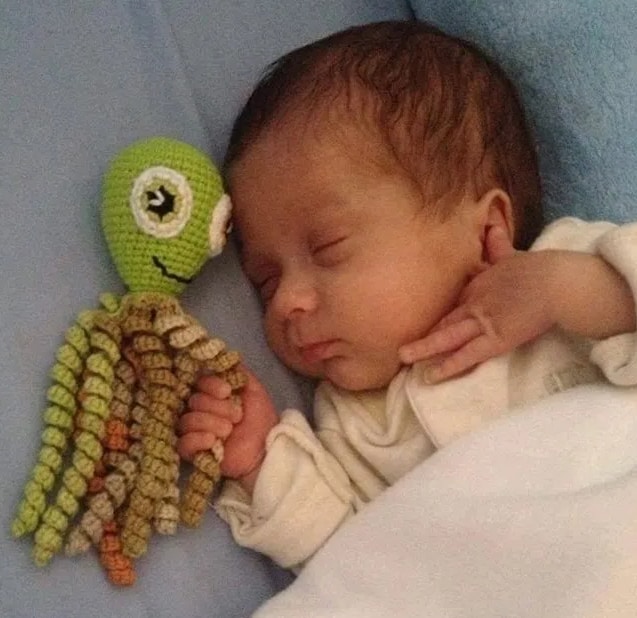I see quite a lot of people wondering if crocheting would be good for their arthritis.
Crochet can help relieve pain and reduce stiffness from arthritis. It improves dexterity and strengthens the muscles in your fingers and hands. Crocheting can improve flexibility and keep hand muscles stronger, which can reduce joint pain.
Before you try to treat any sort of medical condition, you should talk to your doctor first and discuss your plans. They can give you more precise advice on how to begin your new hobby. Your doctor may suggest some exercises or self massage techniques. These can help improve your range of motion and better prepare you for success crocheting.
Why Crocheting Can Reduce Arthritis Symptoms
Arthritis often causes issues in the hands, wrist, fingers, and elbows. All of these are used when you crochet. Since exercise can help you maintain bone and muscle strength, according to the Mayo Clinic, all of these parts of your hand may benefit from crochet.
It’s important to keep your muscles strong because they maintain support for your bones. If your muscles become weak from lack of use, this can lead to more stress on your joints. This can cause your joints to be more stiff and painful.
So crochet can actually help stave off some of the symptoms of arthritis!
Given how fun and addicting crochet can be, it’s important to be mindful to pace yourself. You’ll want to ease into crocheting slowly, too. If you aren’t already an avid crocheter, limit the amount of time you do it at first.
This is especially important if you haven’t been using your hands much recently. If that’s the case, you can more easily overwork your muscles and cause joint pain. Increase the amount of crocheting you do slowly so you don’t strain your hands, or cause a flare-up.
Tips for Crocheting With Arthritis
You might find it helpful to perform a few simple warm-up exercises before you crochet. Here are a few:
- Bend your knuckles: Bend your middle knuckles as if you were making a claw, then straighten your fingers again.
- Fists: Make a fist with your fingers, then slowly straighten them again.
- Touch your fingers: Touch each of your fingertips to your thumb, one by one.
- Walk your fingers: Walk your fingers up the wall, then back down.
If you feel any pain when you do these exercises, stop. Don’t force it.
Soak your hands in warm water, or use a heating pad to warm your hand up before you work. Massage can help get blood flowing to your hands, too.
Periodically check that your fingers, wrists, arms, and shoulders are relaxed, along with the rest of your body.
While crocheting, take breaks often. Use that time to relax your hands, shake them out, or massage them. When you begin again, remember to keep your hands and arms relaxed.
You might also find relief by using hot or cold compresses for pain and swelling. Your doctor would be able to give you better guidance for what type of compress you should use.
Learn your limits and stick to them. We’ve all felt that temptation to churn out “just one more row!” but it’s important to not overdo crochet. Many crocheteres – including myself – have learned the hard way that if you overwork your hands, you’ll pay for it later. That might mean no crocheting for days or weeks while you let your hands rest. So pace yourself! That project will still be there tomorrow.
Some crocheters learn to be ambidextrous, meaning they can use the crochet hook in both their left or right hands. This way, you can switch which hand you use, and let your hook hand rest.
Try out multiple ways to hold your hook. A few popular ways to hold your hook include:
- The knife hold

- The pencil hold

- The piano hold

- The saber hold
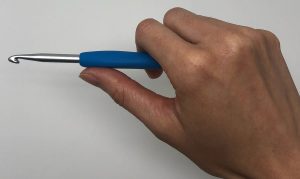
- Or the chopstick hold
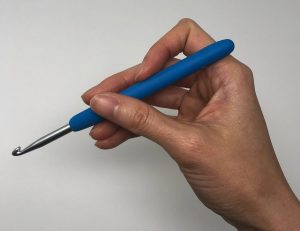
Pick the ones that feel most comfortable to you. There are also multiple ways you can hold the working yarn and the project. If you mix and match combinations of these, you can find the one that suits you best.
You can also switch how you hold the hook every so often. This gives certain muscle groups a break while you continue to crochet.
Switch the finger that controls the yarn tension every 10 minutes. This gives some of your fingers a break.
You can also change the level of tension on the yarn. Usually, you want to keep the same level of tension throughout a project. This might mean you’ll have to switch projects every so often.
Switching projects also gives you the chance to work with a different hook size or yarn weight.
A change in projects can cause you to change your posture and how you hold the project. This lets you relax certain muscles and start using others.
Stay mindful of how you hold your project. Sometimes, crocheters end up holding their project too tightly without realizing it, causing pain.
Get the right tools:
You may be able to find splints for your wrist, thumb, or fingers that can provide extra support.
Braces or fingerless gloves that are specially designed for crafting with arthritis are popular among crocheters. You can find these in medical supply stores, or online. They can make crafting a lot easier, and prevent pain while keeping your hands warm.
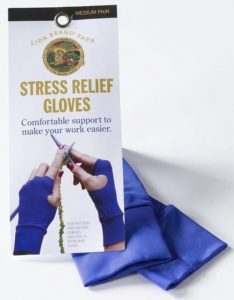
Some crafters find it helpful to wear such gloves overnight.
Experiment with different types of material. Some types of yarn are stretchier than others. Wool yarn tends to be more elastic and flexible. You might find it more comfortable to work wool than with acrylic or cotton yarn.
Find a comfortable ergonomic hook that suits you. These are specially designed to reduce pain.
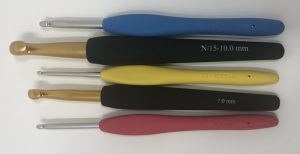
You can buy hooks with soft grips, or you can make your own. Another option is to use soft grips for pencils. These can be put onto your hooks.

Get an ergonomic “egg” handle for your hooks. There are very large handles shaped like an egg. The material is plastic but feels rubbery for easy gripping. You put your hooks inside, and the handle holds it in place. Then you crochet using this large handle that’s easy to hold.
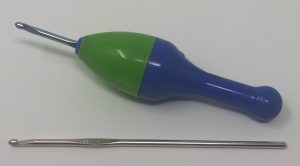
You can also work with larger hooks and yarn with a thicker weight. This can make it easier to hold.
Hook material is another consideration. It might be a good idea to avoid cold metal hooks, which can often be heavier. Plastic and bamboo hooks are often lighter, and won’t steal as much heat from your hands.
Make sure you have a comfortable setup that provides support for your arms and back. This will help you maintain good posture. Slouching can cause headaches, backaches, or neck pain.It can also decrease circulation to certain parts of your body.
Have what you need handy to see your work easily without straining. This might mean having a magnifying glass, a brightly lit area, or reading glasses close by.
Crochet Can Slow Down Some Effects of Aging
Arthritis can affect people of all ages, but for seniors who suffer from arthritis, crochet can be a good cure for boredom. It can also provide mental stimulation that can help them maintain healthy cognitive ability. Learning a new skill such as crochet has also been said to slow cognitive aging, which can help stave off dementia and alzheimers.
Crocheting is also a fun and creative way to express yourself. Your town might have a few yarn groups that meet up regularly. This is a good way to meet new friends.
People who crochet report feeling happier, calmer, and better able to focus, according to a study done by the University of Wollongong Australia. Over 70% of crocheters surveyed said crochet improved their memory and concentration. Dr. Pippa Burns, who worked on the survey, commented that this may encourage people to take up crocheting as a self-care strategy.
Crochet is Good for the Soul, Too
Crocheting can also relax your mind and body enough to make bedtime a little easier, according to the American Counseling Association. Many people also find that crocheting helps reduce anxiety and promote relaxation, because they have something repetitive to focus on.

